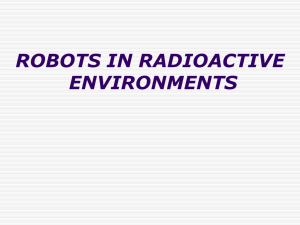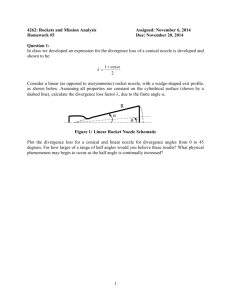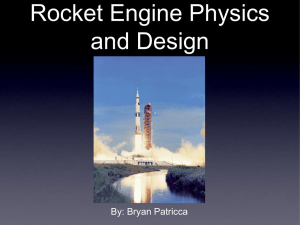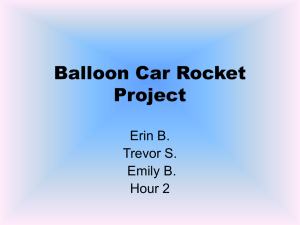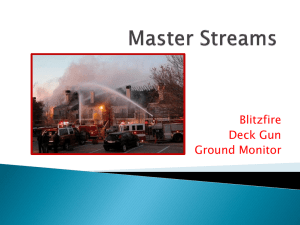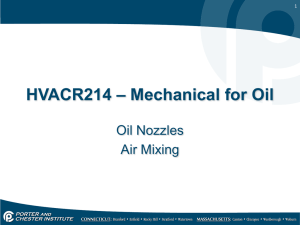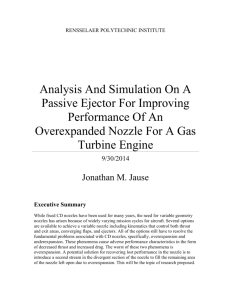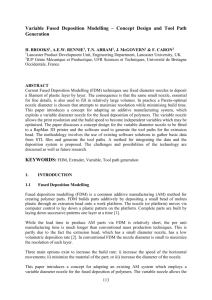AE8129RocketIntro1
advertisement
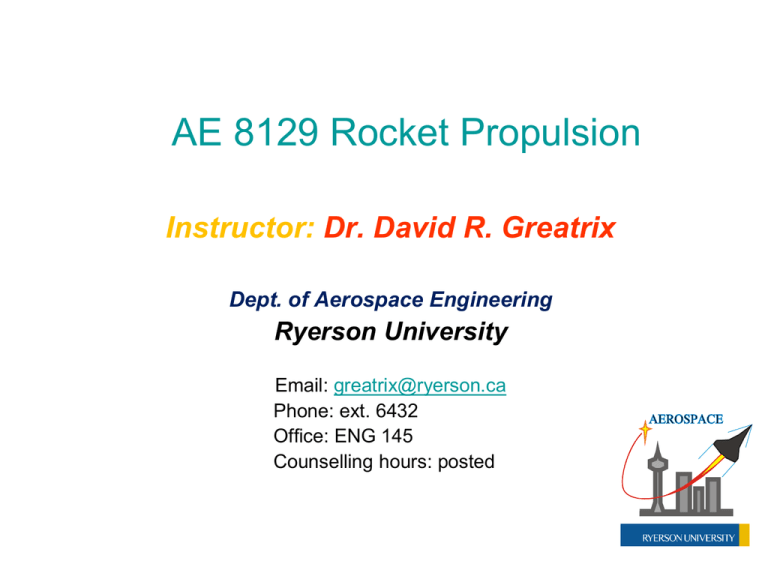
AE 8129 Rocket Propulsion
Instructor: Dr. David R. Greatrix
Dept. of Aerospace Engineering
Ryerson University
Email: greatrix@ryerson.ca
Phone: ext. 6432
Office: ENG 145
Counselling hours: posted
Additonal Logistics
• Lecture in ENG LG12, Wed., 9 am – noon
• Run first part of class from 9:10 am –
10:30 pm, break for half-hour, second part
from 11:00 am – noon
• Tutorial (sample problems) incorporated
into lectures; counselling hours flexible,
my office (ENG 145), if I’m available
Logistics (cont’d)
• Evaluation:
1 Indiv. Proj. Report 25%
Oct. 26 (9:10 – 10:00 am)1 Term Test, 50 min.
25%
Univ. will sched. in Dec.
Final Exam, 3 hr. 50%
• No official course textbook; recommended
books are useful for project and filling in
gaps in understanding
• Tests are open lecture notes + practice
problem/soln. set + regular calculator
Logistics (cont’d)
• Project may involve computer
programming and/or spreadsheet analysis,
at your discretion
• Zero marks for late project submission
Outline of Course:
Introduction
Solid-Propellant Rocket Motors
Liquid-Propellant Rocket Engines
Hybrid Rocket Engines
Air-Breathing Rocket Engines
Non-Chemical Space Propulsion
Systems
Delta II Launch Vehicle
Introduction to Rocket Propulsion
• One associates rocket propulsion with
space flight, but applications range from
lower atmosphere to outer space
• Emphasis in this course on chemical
systems, employing combustion as the
means for heat generation; later, will look at
less conventional non-chemical approaches
• Thrust produced by exhausting a hot highspeed gas (conventional approach)
Mission Requirements
• Range of applications for rocket-based
systems is considerable, from low end (e.g.,
pilot ejection seat) to high end (e.g., heavy
space launch vehicle)
• Let’s consider a simpler example, where the
flight dynamics equations are more readily
calculated: vertical ascent by a rocket
vehicle
Schematic diagram of single-stage rocket vehicle at sea level launch,
quadrant elevation angle o = 90.
Gravity:
RE
g go (
)2
RE hASL
Vertical ascent o.d.e. :
Propellant consumption :
dV F D
g
dt
m
F
m
I sp g o
Aerodynamic drag:
Updated o.d.e. :
1
D C D V 2 S
2
dV
dt
, neglect
F01
g
F
mo ( 01 )t
I sp ,1 g o
Integrate to arrive at:
F01
V ( t ) g o I sp ,1n( 1
t ) g1t
I sp ,1mo g o
, 0 < t < tB1
Further integration provides height attained:
t
y Vdt g o I sp ,1 [(
0
mo g o I sp ,1
F01
F01
t2
t )n( 1
t ) t ] g1
mo g o I sp ,1
2
Move to two motor stages:
First stage burn time:
t B1
I sp ,1mP1 g o
F01
Vehicle mass at beginning of 2nd stage firing:
m1 mo mP1 mE1
Vehicle velocity at end of 2nd stage firing:
mP1
mP1
mP 2
mP 2 I sp ,2
V2 g o I sp ,1 { n( 1
) g1
( n( 1
) g2
)
}
mo
Fo ,1
m1
Fo ,2 I sp ,1
Vehicle velocity at end of 1st stage burn:
mP1
mP1
V1 g o I sp ,1 { n( 1
) g1
}
mo
Fo ,1
Vertical height at end of 2nd stage burn:
h2
g o2 I sp2 ,1
Fo ,1
V1 [
m P1
g1 I sp ,1 m P1 g o 2
[( mo m P1 )n( 1
) m p1 ]
[
]
mo
2
Fo ,1
I sp ,2 m P 2 g o
Fo ,2
]
g o2 I sp2 ,2
Fo ,2
[( m1 m P 2 )n( 1
Vertical ascent apogee:
hmax
V22
h2
2g3
mP 2
g I sp ,2 m P 2 g o 2
) mP 2 ] 2 [
]
m1
2
Fo ,2
1
2
2
V
1
RE h2 2 g o RE2
RE
Saturn V (Apollo)
Flight trajectory of multi-stage launch vehicle up to orbital altitude & speed.
Soyuz launch vehicle
Ideal Rocket Equation:
m final
minitial
V
V
exp(
) exp(
)
I sp g o
ue
Space Shuttle (STS) Delta-V Budget (3 stages):
Desired (nominal) orbital velocity
Gravity losses
Pitch angle trajectory adjustment
Atmospheric drag losses
Final orbital insertion
Minor correction manoeuvres
Inertial assist from Earth rotation, lat. = 28.5
Total required mission velocity (V)
7790 m/s
1220 m/s
360 m/s
118 m/s
145 m/s
62 m/s
- 408 m/s
CCCCC
9347 m/s
Gasdynamics/Thermodynamics
Thrust:
F C F pc At
Classic contour bell nozzle
e ue ( pe p ) Ae
F m
Exit gas velocity and mass flow:
pe
2
u e ae Mae [ RTF (
){1 (
)
1
pc
m t m e
1
2
At pc [
(
)
c*
RTF 1
1
1
1
] 1 / 2 At pc
}] 1 / 2
Quick Thermodynamics Review
p
T
M
RT
RT
v
h CvT RT (Cv R)T C pT
Cp
Cv
Cp
Cp R
1
R
1
Cp
p
a RT
Ma
V
a
, ideal gas equation
of state
, enthalpy of gas
, ratio of specific heats
, speed of sound in gas
, flow Mach number
Isentropic Flow
1
p2
T2
T1 p1
1
2 p 2 v1
1 p1
v2
T2 2 ( 1) Ma12
2
T1 2 ( 1) Ma2
Area-Mach Number relation:
At Mae 2 ( 1 )Ma
[
]
Ae Mat 2 ( 1 )Ma
2
t
2
e
1
2( 1 )
Exit pressure:
pe pc [ 1
1
2
Mae2 ]
1
Thrust:
pe
F C F At pc C F ,v [ 1 (
)
pc
C F ,v [
1
] 1 / 2 At pc ( pe p ) Ae
2
2
(
)
1 1
2
1
1
]1/ 2
Flow characteristics in convergent/divergent nozzle as chamber pressure
is progressively increased relative to constant outside air pressure. Case
(1): subsonic flow throughout. Case (2): flow has become choked, with
flow ahead of upstream-facing standing normal shock S2 being
supersonic, and subsonic downstream (overexpanded nozzle). Case (3):
standing normal shock S3, with bigger pressure increase across it than
S2, is positioned very near to the nozzle exit plane (overexpanded
nozzle). Inviscid flow assumed.
Flow characteristics in convergent/divergent nozzle as chamber pressure
is progressively increased relative to constant outside air pressure. Case
(4): supersonic flow throughout internal nozzle region; upstream-facing
oblique shock S4 with supersonic flow upstream and downstream to
bring pressure up towards ambient level (overexpanded nozzle). Case
(5): flow has reached design point, exit-plane exhaust at ambient air
pressure. Case (6): exit-plane exhaust pressure now exceeds outside air
pressure, thus producing an upstream-facing Prandtl-Meyer rarefaction
(expansion) wave to bring pressure down (underexpanded nozzle).2
Inviscid flow assumed.
Nominal exhaust flow patterns for an overexpanded supersonic nozzle
(upper diagram; Case 4 of previous slide) and an underexpanded supersonic
nozzle (lower diagram; Case 6 of previous slide).
Example flow contour diagram (contours of velocity magnitude in m/s) of
steady channel gas flow passing through a choked 2D-axisymmetric
convergent-divergent nozzle moving from left to right into the open
atmosphere; viscous-flow CFD simulation via FLUENT V5.4 . Diagram
shows upper half of flow field, with flow centerline along the bottom
boundary. A standing normal shock is evident in the nozzle divergence
section, indicative of an overexpanded nozzle. The flow is separated from
the nozzle expansion wall downstream of the nozzle throat, resulting in an
exhaust jet that is of relatively constant cross-sectional area as it extends
and expands downstream.
Specific impulse (instantaneous):
I sp
F
m g o
Average specific impulse:
1
1 tb
I sp
I tot
Fdt
gomp
gomp 0
Standard Nozzle Designs
SRM examples
LRE example (bell nozzle, Rocketdyne RS-51)
Alternative Nozzle Designs
E-D = expansion-deflection, R-F = radial-flow, H-F = horizontal-flow
Expansion-deflection nozzle (pintled nozzle variant; pintle forces
flow outward to the nozzle expansion walls; flow moving left to right
in diagram below)
Stepped nozzle variant (G.P. Sutton design;
nozzle expansion insert ejected later in flight,
at higher altitude)
Alternative Nozzle Designs (cont’d)
NASA/Lockheed Martin X-33 (VentureStar orbital
spaceplane program, subscale technology
demonstrator), utilizing two side-by-side liquid-propellant
Rocketdyne XRS-2200 aerospike-nozzled engines
X-33 in orbital flight over Earth’s surface
Combustion Review
Reaction, ideal result:
H2
1
O 2 H 2 O Qr
2
1
( 32 kg per mole)
mO m O 2
r
8:1
m F m F
1(2 kg per mole)
stoichiometric oxidizer-to-fuel ratio
Molecular mass of ideal stoichiometric product of
combustion (reaction):
M 2 16 18 amu, water vapour
+ heat energy
Non-ideal chemical reaction:
aH 2 bO2 nH2O H 2 O nH2 H 2 nO2 O2 nO O nH H nOH OH Qr
Molecular mass of non-ideal product of combustion :
n jM j 18nH 2O 2nH 2 32nO2 16nO nH 17nOH
M
nH 2O nH 2 nO2 nO n H nOH
nj
Resulting gas specific heat:
n j C p, j
Cp
nj
Resulting gas ratio of specific heats:
Cp
Cv
Cp
Cp R
Cp
R
Cp
M
Flame Structure
• Premixed laminar flame, first category;
process of combustion is driven
predominantly by pressure
• Turbulent diffusion flame, second
category; process of combustion is driven
predominantly by mixing
• Commonly in propulsion system
combustors, flame is a combination of the
above two

